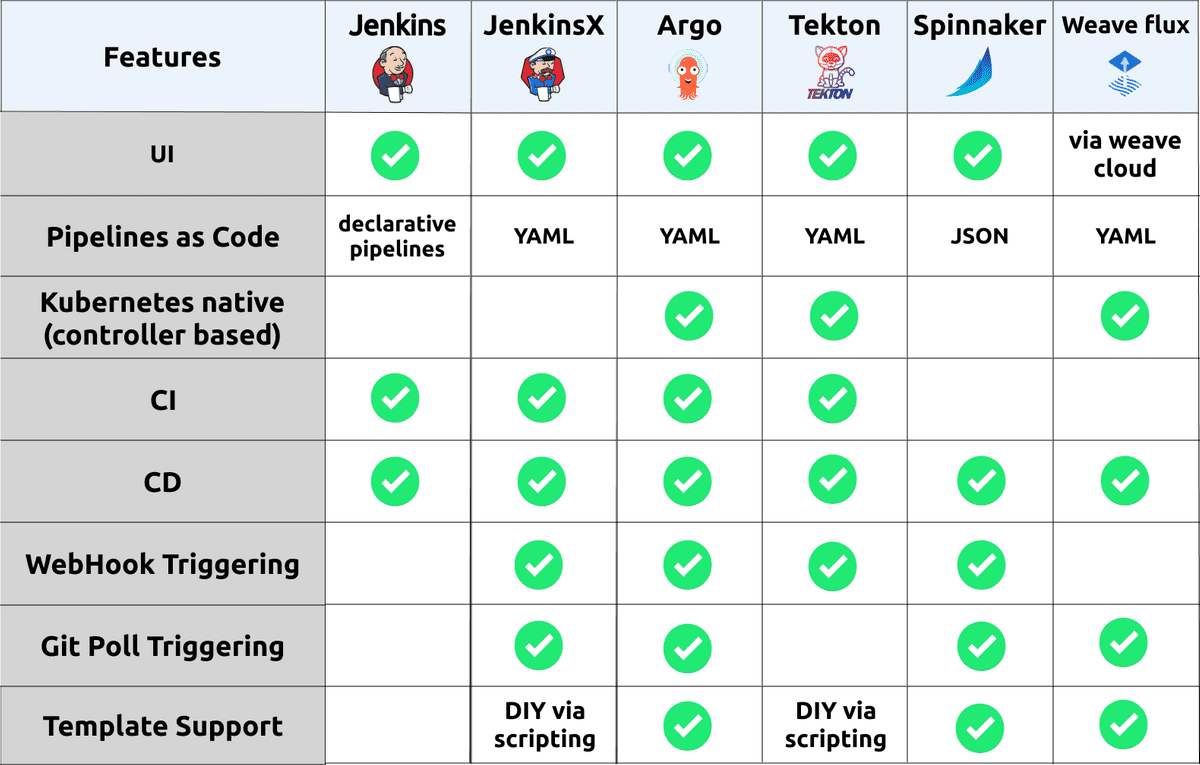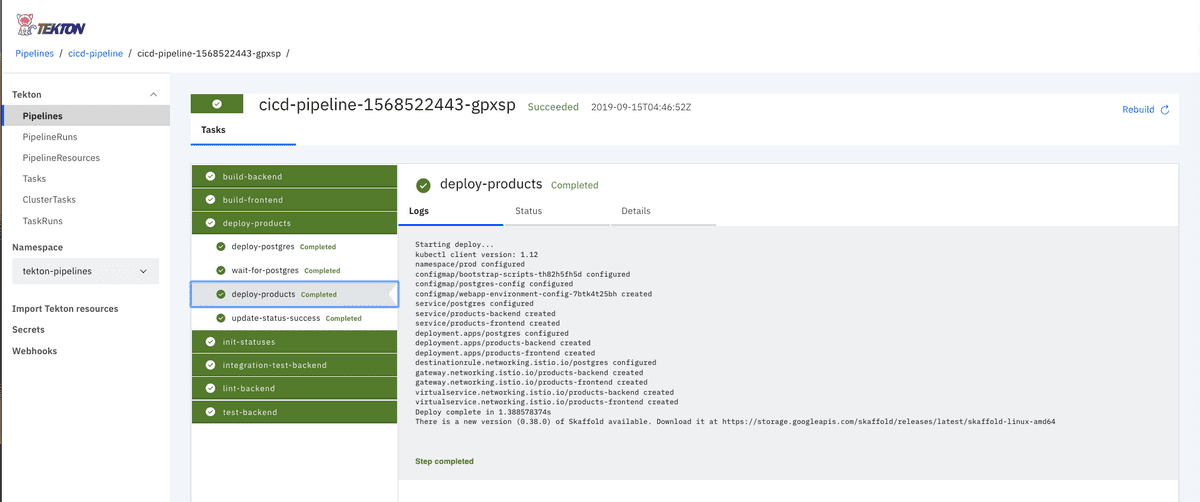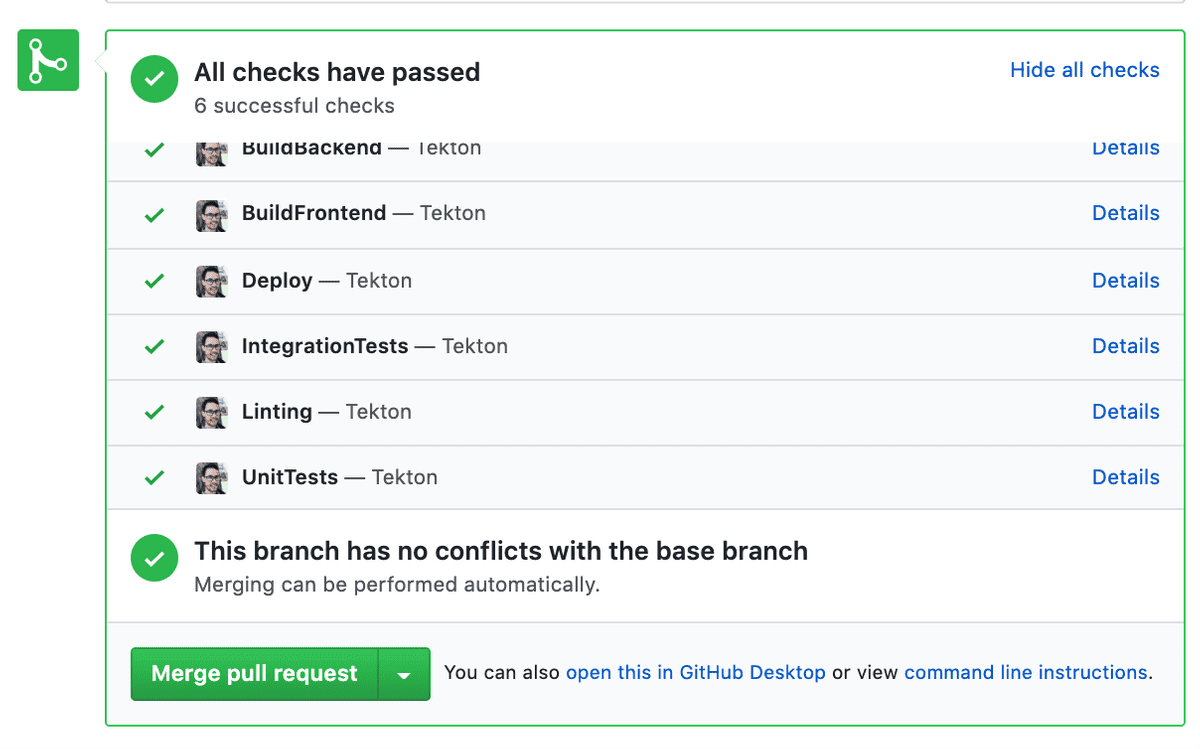Ben Ebsworth
Kubernetes-centric Continuous Delivery - Part 2 (Tekton Pipelines)

September 21, 2019
Overview
Through this article we will explore the current ecosystem of pipelining tooling and then demonstrate an end-to-end example of a Tekton based pipeline, as well as how we can enable things like GitHub Webhooks for triggering pipelines, and the tooling available for visualizing the state of our pipeline.
The pipelining we’ll explore today acts to implement two hemispheres of application development and deployment - Continuous Integration (linting, testing, and build artifacts) and Continuos Delivery (Deploying our application and post-deployment validation/assessment).
Pipelining ecosystem
The pipelining/workflow/CI/CD tooling ecosystem is incredibly rich with many projects out their providing similar feature sets, but perhaps tailoring their solution to specific types of environments. As part of the quick research done for this article, I discovered that there are over 33 projects within the CI/CD category provided by the CNCF, with even more being available outside of whats captured by the CNCF. In this article we’ll focus more specifically tools which are very kubernetes-centric in nature, that is, run specifically within a Kubernetes cluster and can target deploying applications with a strong understanding of Kubernetes resources and life cycle patterns.
So if we do a brief summary of each option i’ve consider “kubernetes-native”, we have the following:
Jenkins - An incumbent player that is commonly used across a lot of organizations. its not that “kubernetes-centric” in the sense that is hasn’t been developed to run natively in Kubernetes. However there has been to make it support working seamlessly within a Kubernetes environment, where ephemeral workers can be created to execute a Jenkins pipeline. This is enabled through a Jenkins plugin called kubernetes-plugin. Jenkins has an incredible rich ecosystem of other plugins which enable a whole range of capability.
Jenkins X - The goal of Jenkins X is to provide an end-to-end cloud native experience, including the management of peripheral tools which aim to meet all of the requirements of a feature rich workflow. These tools include:
- Jenkins - Managing pipelines and orchestration the interaction with Kubernetes and artifact storage
- Nexus - acts as a dependency cache for NodeJS and Java applications to dramatically improve build times
- Docker Registry - an in cluster docker registry where our pipelines push application images
- Chart Museum - a Repository for publishing Helm charts (used when not integrating some given cloud provider option like ECR/GCR)
- Monocular - a UI used for discovering and running Helm charts
- Skaffold - build and push image actions in a pipeline. Managing the integration with cloud provider container registries (GCR, ECR, ACB)
- Tekton - providing the reconciliation engine for running underlying CI and CD pipelines and/or tasks
From my initial inspection it looks fairly complex, but does provide a full solution. The use of Jenkins within Jenkins X is fairly abstract and not something that needs to be directly interacted with, this can be favorable as there can be overheads using Jenkins directly. The final result is a nice interface for defining a pipeline with given steps, a reference for this “front-end” interface can be found here. The opinionated structure of Jenkins X may not be flexible enough for some teams, but may provide a safe and quick start for teams starting their Kubernetes journey, looking to have a “best practice” end-to-end implementation provided for their CI/CD workflow.
ArgoCD - A fast growing pipeline/workflow toolset. Providing a clean model for representing an applications life cycle through the available CRD’s Application and Workflow, these primitives provide an incredibly complete mechanism for deploying and managing a variety of Kubernetes based applications with potentially different requirements/setups. The Argo Project tooling also has nice integrations with common templating tools such as Helm,Skaffold, and Jsonnet. With these capabilities, ArgoCD seems to be the best solution available for enabling a production-grade CI/CD pipelining solution flexible enough to support most environments. Some more information on project layout and how to get started can be found here.
Tekton - Providing primitive constructs for developing rich pipelining capabilities, where higher level abstractions and/or frameworks could be constructed on top. You could think of Tekton as providing a similar capability as Argo Workflows. The Tekton project has a number of actively developing tools within the GitHub organization, looking to providing the peripheral capabilities like trigger/eventing, dashboard/ui and a cli. With backing from Google/GoogleCloudPlatform the project will hopefully continue to be extended and mature into having a stronger awareness of application delivery. Or in the meantime using something like Skaffold or ArgoCD’s tooling via Tekton could be sufficient. I can see Tekton becoming a defacto standard for teams looking for a hybrid cloud solution for pipelining, where you can literally run it anywhere Kubernetes runs.
Spinnaker - Perhaps one of the most mature and fully featured solutions. Having been birthed out of the need of scaling to Netflix’s size, it has a lot of features which meet a larger enterprises requirements. Consequently it is a fairly complex solution to run, comprised of over 10 microservices which enable the end-to-end capability. This can all be deployed within a Kubernetes cluster and the Kubernetes V2 provider enables Spinnaker to manage a Kubernetes based application deployment environment natively. If you are within an organization looking to scale a pipelining solution across a number of Kubernetes cluster and a large number of applications, this could be a good fit.
WeaveFlux - With an strong focus on enabling GitOps workflows, WeaveFlux provides a structured way of managing the promotion of their concept of a
HelmReleasethrough different environments. TheHelmReleaseis a CRD which is consumed by the WeaveFlux operation to work out which Helm chart to use and how it should release an associated version of an application. The GitOps workflow has some expectations around effectuating a Git repository with changes occurring in the release, so you must give access to your deployment repository. Additionally, it uses Helm’s Tiller component, this has some security concerns - where the tiller component must have escalated privileges to deploy, which is harder to control via RBAC - something to be mitigated in Helm v3. Some more information on a project layout and how to get started can be found here
With these summaries in mind, we’ve got a practical implementation of one of these options (Tekton) below. The idea is to expand on each of these described options in more detail and also demonstrate the end-to-end capability available on the other options. All captured within the kubernetes-cicd
Tekton
We’ve talked in detail about what Tekton is, and more specifically how we can go about using its core primitives in Getting started with Tekton. For this article we’ll go through how we can standup a Tekton environment on GKE using our kubernetes-cicd repository. The instructs are detailed here, but let break down the sections to help explain each of the key components making up our Tekton pipelining stack.
Tekton Control Plane
The Tekton Controller is responsible for implementing the reconciliation loop when we created the set of Tekton CRDS. This involves working out the Directed Acyclic Graph (DAG) and executing the steps in the optimal parallelized order as Pod’s within our Kubernetes cluster.
The deployment consists of two components:
- Controller - Responsible for reconciliation workflow
- Webhook - Acts as an admission controller before creating pipelines, enabling a validation capability of Tekton resources that are applied to the cluster
To deploy the tekton control-plane from our kubernetes-cicd, run the following:
make component.tekton.install CLUSTER=[local|gke|...]Where CLUSTER can be set to either
localorgke, which enables you to target an environment more specifically with potentially different configuration.
On a successful deployment you should see the following Pod’s running:
$ kubectl get po -n tekton-pipelines
NAME READY STATUS RESTARTS AGE
tekton-pipelines-controller-55c6b5b9f6-5cnq2 1/1 Running 0 3m43s
tekton-pipelines-webhook-6794d5bcc8-l5j2g 1/1 Running 0 3m43sOnce this has completed, we’re ready to start deploying Tekton resources!
Tekton Dashboard
The Tekton Dashboard provides visibility into the state of your TaskRrun, ClusterRun and PipelineRun pipelines, and the ability to view the deployed resources currently existing within your environment.
To install the tekton dashboard component we did need consider a few pre-requisites or dependencies to enable us to make the deployed dashboard available to external users. In the current repository we enable access via Istio, using something as complex as Istio may be unnecessary, however we also utilise Istio with Knative for the webhook trigger capability we describe later in the article - this allows us to trigger PipelineRun’s on GitHub PR’s.
In order to install istio run the following from the root of the kubernetes-cicd repository:
make components.istio.install CLUSTER=[local|gke|...]This will install our istio control and data plane, enable ingress to services running within our Kubernetes cluster.At this point we can install our Tekton dashboard by running:
make components.tekton.dashboard.install CLUSTER=[local|gke|...]Now we need some DNS configured to point to the IP address allocated to our Istio ingress gateway. You can do this in a number of ways, in my case I’m using Google’s Cloud DNS, you can set up your configuration (domain name etc) in the env/${CLUSTER}.parameters file and run the following:
make components.kubernetes.gke.dnsThis entrypoint will discover the IP address allocated to the Global LoadBalancer for your Istio ingressgateway, then create the Zones and RecordSets for the required mapping.
Once everything has been successfully deployed you’ll be able to navigate to your Tekton Dashboard UI, in my default configuration - used for demonstrations etc - this would be at tekton-dashboard.tekton-pipelines.cicd.benebsworth.com. You’ll see the following:
Tekton Webhook Extension
As part of the experimental feature development actively occurring within the Tekton organization there’s the capability to add the Webhook Extension onto the Tekton Dashboard UI. This extension then provides the capability to create and manage *GitHub Webhook’s via the Tekton Dashboard. This has some dependencies on Knative in order to provide a serverless webhook endpoint for GitHub to hit, when hit it will trigger the creation of a PipelineRun which then executes your defined Pipeline.
In order to enable this we’ll first install Knative, run the following:
make components.knative.installThis will deploy Knative to your cluster, Knative has a dependency on Istio, but we’ve installed that in an earlier step 🎉. The specific resource that we get out of the Knative deploy is the GitHubSource, which is part of the set of eventing CRDs available from the knative-contrib tooling available here.
Now with these resources available, we can install the Tekton webhook extension by running the following:
make components.tekton.webhook.installThis will restart your Tekton Dashboard Pod to have the changes take effect, once complete you should see the webhook extension in the UI like below.
This extension will now give us to ability to create a webhook on a target repository. In order to do this, we specify the following:
- target repository to create the webhook on
- the required app-credentials token, created from your github profile here
- the target
PipelineRunto execute when the webhook event in triggered - the
ServiceAccountpermissions to use when creating the givenPipeline
If all goes well you should see a webhook created in your repository like so:
Now when we raise a PR, it will trigger the running of the targeted PipelineRun.
Tekton Triggers
more information available soon! repo is available here
Pipeline
In a previous post - getting started with tekton - we discussed core primitives defined by Tekton. These are used to construct an end-to-end pipeline which manages the linting, testing, building and deployment of our application, all completely self-contained within our Kubernetes cluster.
Where each labeled component is described as follows:
- GitHub Events - Tekton is capable of auto-configuration our target GitHub repository to hit a webhook endpoint on generated events such as
pull_requestandpush. - Webhook Listener - A knative based service, which ephemerally spins up when the webhook endpoint is hit by GitHub. This listener service will be responsible for creating a
PipelineRunfrom the received GitHub event. - PipelineRun - A core primitive in Tekton which is responsible for running a defined
Pipelineresource. Both being represented as Custom Resource Definitions (CRD) and applied to our Kubernetes cluster. - Linting - In order to ensure the quality of code being developed and the formatting and idiosyncrasies of the given languages used. We can also enforce certain syntaxes for things like
Dockerfile’s, Kubernetes resources. In this case we are using golangci-lint metalinter. - Unit Tests - These tests are being run during the pipeline, validating the functionality of specific functions within our application
- Integration Tests - A deeper end-to-end validation of the expected functionality is tested during the Integration Testing phase, these will check the developed API’s responses meet a contact/expected payload. This runs via the in build golang testing capability. It will stimulate the application to make real interactions with any external systems - such as databases, other API’s etc.
- Build Backend Application (Golang) - The golang app is built using Kaniko. This gives us a Dockerless and Rootless build capability of images, as well as some nice remote cache optimization options on a per-layer basis.
- Build Frontend Application (React) - Stock standard build of a webpack based project. Kaniko is also responsible for this build, and can directly consume the
Dockerfilewe’ve defined for the application. - Deploy Application - Once all of the linting, testing, and building are successful, we are ready to deploy the application. This is done using
Skaffoldwhich has a “production” profile. This captures the required configuration and mapping of the resources we’ll need for the production environment. Skaffold is providing a consistent interfacing for deploying, whether that be in our local/staging environment or to production via a pipeline. We discuss Skaffold in further detail in Kubernetes-centric Continuous Delivery - Part 1 (Developer Experience) - Google Kubernetes Engine - At the heart of this is Kubernetes, in this case we’re using Google Cloud Platform (GCP) Kubernetes offering GKE. The coolest part of the GKE service is the ability to scale to zero, where your worker nodes will be scale down to zero, and you don’t pay for the Kubernetes API Server and other control-plane components. It’s within the kubernetes substrate that we deploy our end-to-end platform stack.
This above described pipeline can be found here. You’ll see this is a fairly complex and feature rich pipeline. Because of Tekton’s verbosity it does become quite complex, but the idea is really to abstract from these lower-level primitives to simplify the user experience and enable re-usability, templating and validation of policy as its consumed/defined.
Pipeline Status
Within each stage of our Pipeline we’re able to provide feedback relating to how each stage has proceeded. This results in the final status check view within our PR:
PipelineRun!This is achieved pretty simply by running the following step within our tekton pipeline which gits the github status API:
apiVersion: tekton.dev/v1alpha1
kind: Task
metadata:
name: backend-unit-tests
spec:
inputs:
resources:
- ...
params:
- ...
steps:
- name: update-status-success
image: castlemilk/curl
command:
- /bin/sh
args:
- '-c'
- |
curl 'https://api.github.com/repos/castlemilk/kubernetes-cicd/statuses/${inputs.resources.workspace.revision}?access_token=_GITHUB_STATUS_TOKEN' \
-H 'Content-Type: application/json' \
-X POST \
-d '{"state": "success", "description": "Tekton", "context": "UnitTests","target_url": "http://tekton-dashboard.tekton-pipelines.cicd.benebsworth.com/#/namespaces/tekton-pipelines/pipelineruns"}'This way we can contextualize our status according to the given step.
Wrap Up
Hopefully you’ve gotten a feel for how Tekton can be used to deliver fairly rich pipelining capabilities for the Continuous Integration and Continuous Delivery of applications. Where with the primitives available we can construct arbitrarily sophisticated steps in our pipelines to achieve the required outcomes for our application and environments. The space of Kubernetes native pipelining of heating up and I’m excited to see the future developments of Tekton and the other tools we’ve mentioned. Through the kubernetes-cicd repository we’ll explore the other available options such as the Argo Project, demonstrating a similar end-to-end application CI/CD workflow. Please follow this repository for future developments 😀
Written by Ben Ebsworth, thoughts are their own and any material is representative of an attempt to self-educate and explore ideas and technology You should follow him on Twitter






